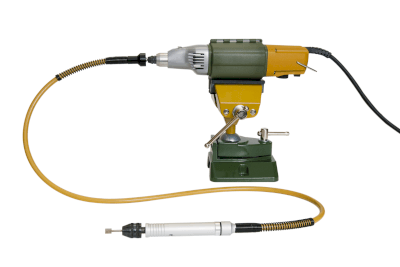What Is a Flexible Shaft?

A flexible shaft is a flexible shaft that transmits rotational motion between two distant points when the rotation shafts are not concentric (the longitudinal centers of the shafts are not the same).
The flexible shaft transmits rotation and torque from the drive shaft side to the driven shaft side while maintaining an appropriate bend between the shaft ends.
Therefore, the rotating shafts of the equipment do not need to be concentric with each other, allowing for a certain degree of freedom of arrangement. This eliminates the need for accurate centering between the rotating shafts of the equipment (aligning the center of the shafts with each other) and improves workability.
Uses of Flexible Shafts
Flexible shafts are used for power transmission and remote control.
- For Power Transmission
Flexible shafts are used when the driven shaft position is not concentric when transmitting power from an electric motor, etc. - For Remote Operation
Used for manual operation of rotating equipment or remote operation of valve opening/closing.
Familiar examples include flexible bits and flexible screwdrivers for extensions of electric drills and screwdrivers, handles for remote opening and closing of windows in high places, and speedometers for automobiles.
Structure of Flexible Shafts
A typical flexible shaft consists of the following three parts The inner core (inner shaft), the outer flexible tube (outer tube or housing), and a fitting at the shaft end.
1. Core
The core consists of one core wire in the center and multiple steel wires wrapped around the core wire, alternating the direction of wrapping to produce several layers. SW-C JIS G3521 hard steel wire or SUS304WP-B JIS G4314 stainless steel wire for springs can be used for the core material.
The characteristics differ depending on the number of wires per layer, wire diameter, number of wire layers, spacing between wires, and material.
2. Flexible Tube
Mild steel wire and hard steel wire are combined and wound together. The outer surface of the wound flat steel wire is sometimes covered with a resin such as synthetic rubber, polyethylene, or vinyl chloride.
The gap between the core and the flexible tube is filled with grease or other lubricant, and the inner surface of the flexible tube acts as a bearing for the core to maintain smooth rotation.
3. Shaft End
This is a metal fitting that connects the drive side and the driven side. It is attached to the core by crimping (caulking), welding, or brazing.
Principle of Flexible Shafts
1. Core
The core is the backbone of a flexible shaft that maintains its bent state and transmits rotation. The winding of the outermost layer of the core determines the direction of rotation of the flexible shaft itself. When the outermost layer is left-handed (leftward), it is for right-handed rotation (clockwise CW), and when the outermost layer is right-handed (rightward), it is for left-handed rotation (counterclockwise CCW).
2. Flexible Tube
Flexible tubing protects the core from dust and moisture. It externally supports the core as it rotates to keep it free from torsion.
3. Shaft End
This part is used to connect the flexible shaft to the rotating shaft. It should be selected according to the connection method and shape of the other side to be connected.
Types of Flexible Shafts
Flexible tube types include standard type, high-torque type, dual-use type, hardened type, strong type, and flexible type.
1. Standard Type
Steel wire is wound into a tubular shape and the outer surface is covered with vinyl or rubber. Highly durable and strong in torque transmission.
2. High-Torque Type
Flat steel wire is wound into a spring-like tubular liner and its outer surface is reinforced with braided steel wire, and the outermost layer is covered with vinyl or rubber. It is capable of withstanding high torque.
3. Dual-Use (Left-Right) Type
Used as an extension of a screwdriver and structurally resistant to reverse rotation.
4. Quenching Type
Heated in a continuous quenching furnace and manufactured through quenching oil. It has excellent straightness and is suitable for remote control.
5. Strong Type
Highly resistant to impact and useful for heavy-duty grinding.
6. Flexible Type
Flexible and easy to bend.